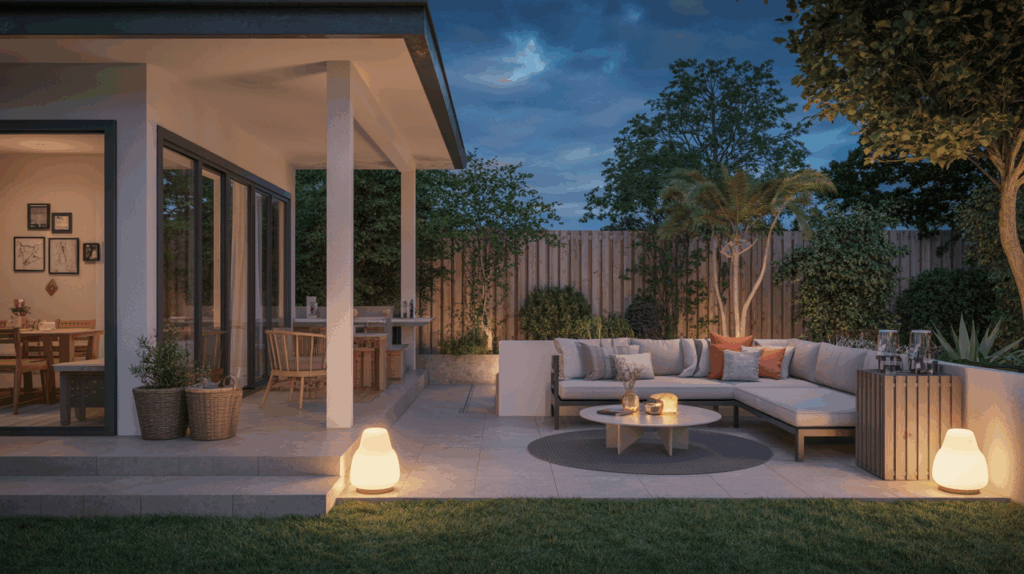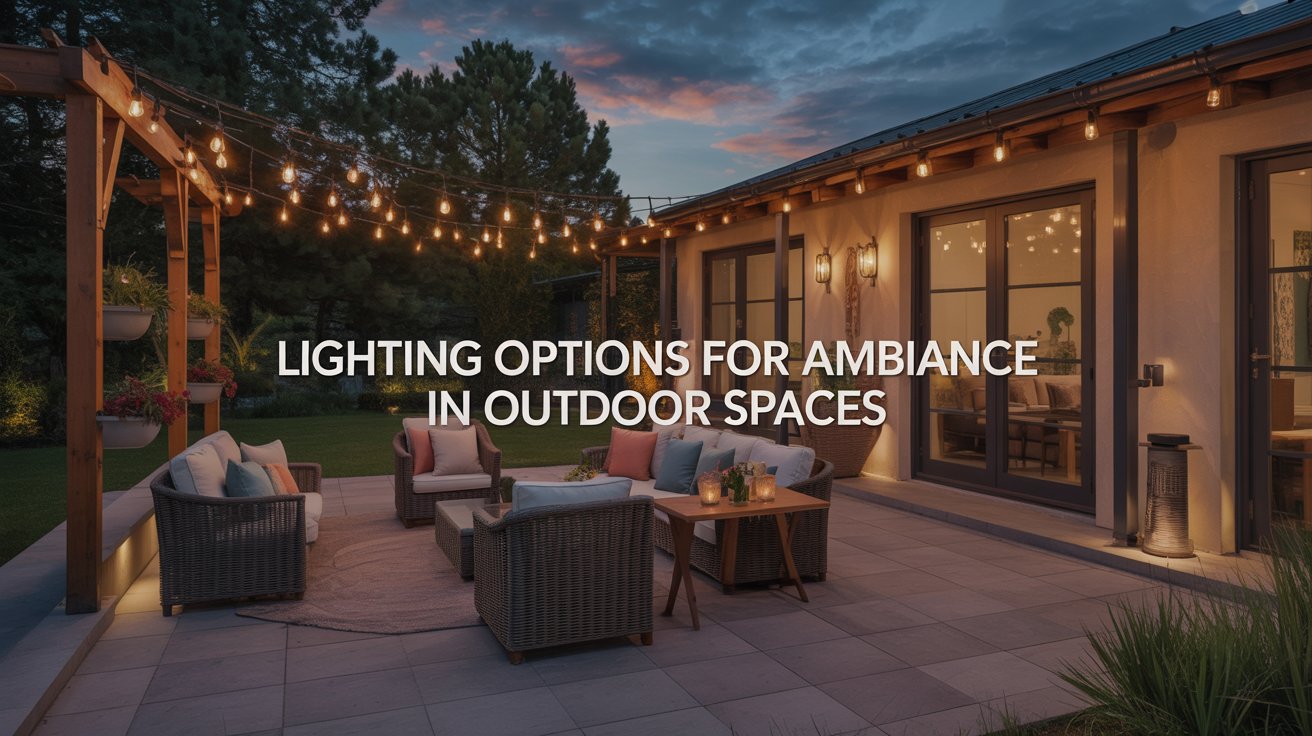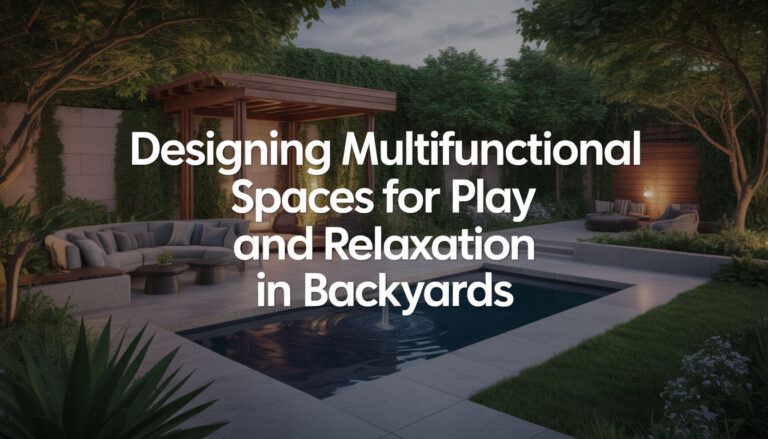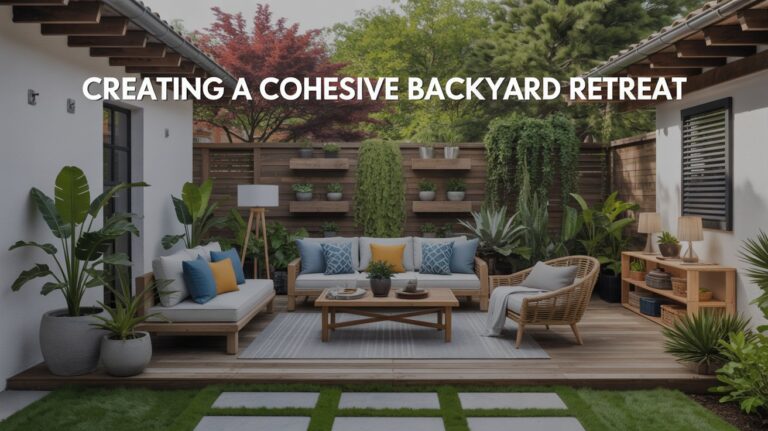Exploring Lighting Options to Create Ambiance in Outdoor Spaces
I have been, or can be if you click on a link and make a purchase, compensated via a cash payment, gift, or something else of value for writing this post. As an Amazon Associate, I earn from qualifying purchases. Please read my full Affiliate Disclosure for more information.
Layer your outdoor ambiance with layered lighting: ambient for general glow, task for activities, and accent to sculpt textures and features. Choose color temperatures by mood—cooler near paths (around 4000K) for safety, warmer in lounges (2700–3000K) for comfort. Use weather-ready fixtures, durable IP-rated housings, and smart controls for scenes, dimming, and schedules. Highlight architecture and landscape with targeted accents, grazing, and uplights. String lights add a warm overhead halo, balanced with pathway illumination. Curious what comes next? You’ll uncover more practical techniques.
Key Takeaways
- Combine ambient, task, and accent lighting for mood and functionality across outdoor zones.
- Use layering (downlights, wall washes, uplights) with zoning for dining, lounging, and pathways.
- Choose weather-resistant fixtures with appropriate IP ratings and durable wiring for reliability.
- Implement smart controls and scenes to adjust brightness, color, and transitions by activity and time.
- Highlight architectural and landscape features with targeted accents while testing angles and maintaining glare control.
Layering Light for Outdoor Ambiance
Layering light for outdoor ambiance means layering intensity, color, and direction to shape mood and function. You combine layers to control visibility, safety, and atmosphere, using a balanced mix of ambient, task, and accent illumination. Smart technology can automate scenes, adjust brightness, and respond to sensors without you micromanaging. Decorative fixtures add character while delivering reliable light distribution, guiding movement and highlighting landscape features. Place ambient fixtures for general fill, task lights where you cook or read, and accents to reveal textures. Consider glare, color rendering, and energy efficiency, ensuring consistency across zones for a cohesive, inviting exterior experience.

Choosing Color Temperature for Outdoor Spaces
Choosing color temperature for outdoor spaces means matching light warmth to function and mood, so your paths glow with clarity while seating areas feel inviting. You’ll balance color temperature to shape outdoor ambiance, recognizing how cooler temps sharpen edges for safety and navigation, while warmer temps foster comfort and sociability. Consider CRI and consistency across fixtures to avoid jarring shifts. A practical approach blends 2700–3000K for intimate zones with 4000K for task-oriented paths, reserving higher temps for accents sparingly. Document your choices, test at night, and prioritize gradual progressions. Your design gains depth, coherence, and a deliberate, enduring outdoor ambiance. color temperature, outdoor ambiance
Lighting Zones: Dining, Lounging, and Pathways
Ever wondered how a well-zoned outdoor space guides the eye and your mood? In this layout,Dining zones require focused task lighting for meals and conversation, while Lounging areas benefit from soft, ambient glow to invite lingering. Pathways demand level, even illumination with color temperature suited to visibility and safety, shaping flow from entry to seating. Use layered layers: downlights, wall wash, and subtle bollards to carve rooms without glare. This approach supports landscaping aesthetics and outdoor safety, preventing trips while highlighting textures. Precision zoning reduces shadows, enhances function, and preserves atmosphere as you move between spaces.
Weather-Resistant and Durable Lighting Options
When you choose weatherproof materials, you guarantee your fixtures resist corrosion, moisture, and temperature swings for long-term performance. Understanding IP ratings helps you quantify protection against dust and water so you can match outdoor conditions to actual durability. Pair these with durable power options—sealed enclosures, braided cables, and reliable switches—to keep your lighting dependable through the seasons.
Weatherproof Materials
Weatherproof materials are the backbone of reliable outdoor lighting, combining durability with weather resistance so you get consistent performance year after year. You’ll choose components designed for exposure, where seals, housings, and gaskets suppress water ingress while tolerating temperature swings. Weatherproof fixtures ensure safe operation with corrosion-resistant metals and UV-stable plastics, maintaining finish integrity under sun, rain, and wind. Pair these with practical wiring practices and standardized connections for lasting service. Use weatherproof fixtures and water resistant bulbs to minimize maintenance. This approach blends technical rigor with everyday practicality, delivering ambient lighting that remains dependable across seasons and settings.
IP Rating Essentials
IP Rating Essentials: weather resistance isn’t a mood—it’s a spec you can test and trust. You’ll learn how IP ratings separate drizzle from downpour, guiding safer outdoor lighting choices. Think about ingress protection: solids, liquids, and the seals that keep circuits safe. When you select waterproof fixtures, you’re buying time against corrosion, short circuits, and performance loss. Match IP codes to your climate—higher numbers for harsher exposure, lower for sheltered nooks. Practical takeaway: verify rating continuity with gaskets, cables, and housings. In the field, clarity saves you repairs; in installation, precision saves you surprises. Your setup last, without unnecessary risk.
Durable Power Options
Durable power options keep outdoor lighting reliable, even when conditions test the weather seals. You’ll prefer systems designed for reliability, with weather-resistant enclosures and sealed connections that minimize corrosion and short circuits. Think solar chargers for daytime energy capture, ensuring continued illumination after dusk without frequent replenishment. Pair them with robust outdoor outlets, rated for damp or wet environments, so cords stay securely plugged and protected. Choose modular, serviceable components that resist sun fading and temperature swings, enabling straightforward maintenance. This practical approach blends physics with design, giving you dependable ambiance despite rain, wind, or frost.
Accent Lighting to Highlight Architecture and Landscape
Accent lighting draws the eye to architecture and landscape features, shaping perception after dark with focused beams and soft halos. You implement height, angle, and beam control to illuminate focal points without glare, balancing contrast and safety. Landscape accent highlights trees, steps, and textures, while architectural illumination reveals massing, materials, and form. Choose fixtures with color-consistent LEDs, appropriate color temperature, and glare shields to preserve night ambience. Layered layers—up-lighting, down-lighting, and grazing—create depth without overlighting. Plan wiring, junctions, and maintenance access, ensuring consistent performance. Your goal is precise, durable illumination that guides movement and enhances evening aesthetic.
Solar vs. Electric: Energy-Efficient Choices
You’ll compare solar and grid lighting with respect to efficiency and reliability, weighing how each draws from the sun or the power supply to shape daily performance. Consider battery backup: how storage buffers outages, shifts load, and extends usability beyond daylight or dim conditions. This discussion sets the framework for practical choices that balance cost, resilience, and long-term energy impact.
Solar vs. Grid: Efficiency
Solar lighting can cut operating costs and emissions, but its efficiency hinges on system design and usage patterns; when grid power is reliable and responsive, you gain consistent brightness with known costs, yet you miss the long-term savings and resilience solar systems offer. In this comparison, you assess energy delivery, conversion losses, and duty cycles. Solar power provides peak-aligned output and lower marginal emissions, while grid efficiency depends on infrastructure, demand response, and voltage stability. You should map daily usage to panel orientation, storage needs, and controller strategies, recognizing trade-offs between predictable pricing and potential resilience gains from solar investments.
Battery Backup Considerations
Battery backups bring a practical counterbalance to the day-to-day variability of solar or grid power. You’ll weigh backup batteries against continuous lighting needs, considering cycles, depth of discharge, and temperature tolerance. Solar-sourced options favor long-term sustainability, yet electric backup systems often deliver quicker responses and higher efficiency in unpredictable weather. Evaluate power stability across the evening, noting how storage size aligns with fixture load and intended ambiance. Prioritize systems with smart management to avoid unnecessary drain. In practical terms, a well-sized battery set reduces outages, maintains consistent color and intensity, and preserves energy efficiency without sacrificing atmosphere.
String Lights: Installing a Warm Overhead Glow
String lights can transform an outdoor area into a warm, welcoming canopy, and installing them overhead is a straightforward, repeatable process. You’ll plan spacing, choose bulbs, and mount securely to existing structures, ensuring tension and sag are balanced for uniform glow. This approach favors energy efficiency, durability, and simple maintenance, producing festive displays with minimal fuss and standout decorative fixtures.
- Measure span length and anchor points for steady support
- Select wiring, bulbs, and dimmable options for adaptable ambiance
- Test connections, weatherproofing, and sag clearance before illumination
This method blends technical precision with poetic glow, aligning practicality with atmosphere.
Landscape Lighting to Guide and Spotlight
Landscape lighting isn’t just about illumination—it’s a guided, sculpted flow that leads you through the yard and highlights key features. You’ll design pathways with stake-mounted oversized fixtures and low-profile uplights to reveal contours without glare. Timing strategies matter: staggered cueing from dusk to late evening preserves color fidelity and energy efficiency. Spotlight focal points—porches, sculpture, specimen trees—with narrow-beam accents to create intentional drama. Use color accents sparingly, choosing warm whites and subtle hues to complement plantings without overwhelming form. Document runtimes, maintain uniform spacing, and test angles seasonally to ensure consistent, precise, and purposeful illumination.
Dimmers and Controls for Flexible Atmosphere
You’ll set the mood precisely with dimming for mood, letting light scale from glow to glare as rooms shift from day to night. Scene and zone control let you tailor illumination by area and activity, so pathways stay safe and gatherings feel intentional. Energy-efficient scheduling aligns output with your routines, conserving power without compromising atmosphere.
Dimming for Mood
Dimming isn’t just about lowering light levels; it’s about shaping a space as the evening unfolds. You’ll harness controls to modulate intensity, balance color, and reduce glare, crafting mood without chaos. Proper dimming preserves color psychology cues while limiting light pollution, so surroundings feel natural and inviting.
- Fine-tuned scenes with gradual ramps
- Compatible fixtures and dedicated controls
- Profiles that align with activity and ambience
Dimming isn’t merely function; it’s atmosphere you command. With precise curves and steady output, you preserve visibility and texture, avoid over-illumination, and keep outdoor living comfortable as night deepens. Your space adapts, remains legible, and breathes with the environment.
Scene and Zone Control
Scene and Zone Control is where dimming becomes choreography: you’ll map zones, assign scenes, and synchronize fixtures to shift atmosphere without reconfiguring hardware. You’ll balance brightness, color, and timing with smart controls, creating layered effects that respond to events and seasons. Zone groups keep pathways, seating, and entry lit distinctly, while smooth between scenes feel seamless, not abrupt. Color blending lets you tailor hues within each zone, preserving ambience as the setting evolves. Practical interfaces guide you through setup, diagnostics, and calibration, ensuring reliability. The result: flexible atmosphere, precise control, and repeatable, engaging outdoor environments.
Energy-Efficient Scheduling
Energy-efficient scheduling uses smart timers, dimming curves, and occupancy awareness to keep outdoor spaces comfortable while trimming energy use. You’ll apply timing strategies that align lighting with activity, season, and darkness, reducing waste without sacrificing mood. Dimmers modulate brightness for atmosphere, while sensors pause lighting when spaces are unused, delivering immediate energy saving tips. The result is predictable ambiance, lower bills, and smarter control logic you can trust.
- Timing strategies: adaptive schedules, scene-based fades, automatic off-when-empty
- Energy saving tips: daylight harvesting, occupancy sensing, gradual ramping
- Practical balance: comfort, safety, and efficiency in every fixture
Maintenance and Seasonal Care for Outdoor Lighting
Regular upkeep keeps outdoor lighting reliable and safe; with the changing seasons, you’ll want to check fixtures, seals, and wiring for signs of wear and moisture ingress. You assess connections for corrosion, test switches, and verify color consistency across paths. Timing adjustments align with sunset and sunrise shifts, reducing power waste while preserving ambiance. Seasonal decorations demand sturdy mounting, weatherproof housings, and gentle cord routing to prevent wind or hail damage. Document inspection dates and lamp types to simplify future care. You’ll develop a practical routine: rapid visual checks, then precise diagnostics, ensuring resilient, inviting illumination year-round.
Conclusion
In sum, you craft ambiance by layering light and balancing color temperature, zone by zone. You’ll pair dining glare with lounging softness, pathways with guardrails of glow, and architectural accents with landscape accents. Choose weather-resistant fixtures, install dimmers, and choreograph controls for mood and function. Maintain and seasonally refresh, so the glow endures. You’re not just lighting space; you’re shaping atmosphere—technical, practical, and subtly poetic—an outdoor room that responds to you, all night, with controlled, radiant cadence.






